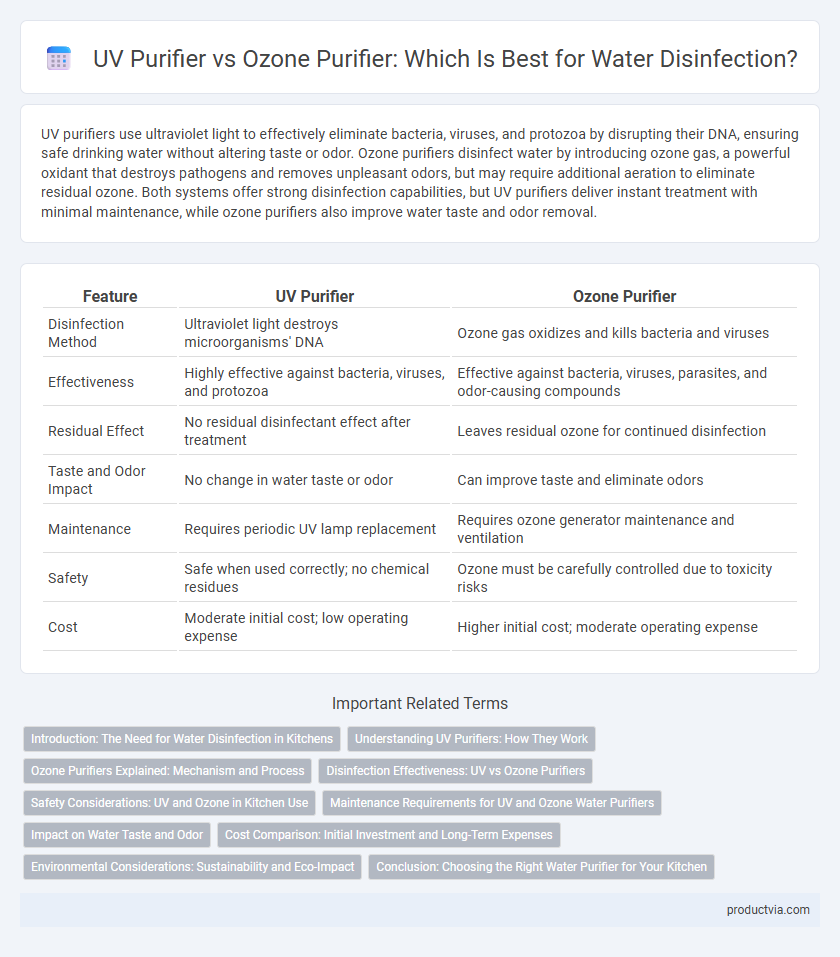UV purifiers use ultraviolet light to effectively eliminate bacteria, viruses, and protozoa by disrupting their DNA, ensuring safe drinking water without altering taste or odor. Ozone purifiers disinfect water by introducing ozone gas, a powerful oxidant that destroys pathogens and removes unpleasant odors, but may require additional aeration to eliminate residual ozone. Both systems offer strong disinfection capabilities, but UV purifiers deliver instant treatment with minimal maintenance, while ozone purifiers also improve water taste and odor removal.
Table of Comparison
| Feature | UV Purifier | Ozone Purifier |
|---|---|---|
| Disinfection Method | Ultraviolet light destroys microorganisms' DNA | Ozone gas oxidizes and kills bacteria and viruses |
| Effectiveness | Highly effective against bacteria, viruses, and protozoa | Effective against bacteria, viruses, parasites, and odor-causing compounds |
| Residual Effect | No residual disinfectant effect after treatment | Leaves residual ozone for continued disinfection |
| Taste and Odor Impact | No change in water taste or odor | Can improve taste and eliminate odors |
| Maintenance | Requires periodic UV lamp replacement | Requires ozone generator maintenance and ventilation |
| Safety | Safe when used correctly; no chemical residues | Ozone must be carefully controlled due to toxicity risks |
| Cost | Moderate initial cost; low operating expense | Higher initial cost; moderate operating expense |
Introduction: The Need for Water Disinfection in Kitchens
Water disinfection in kitchens is essential to eliminate harmful pathogens and ensure safe drinking water. UV purifiers use ultraviolet light to destroy bacteria and viruses by disrupting their DNA, effectively preventing waterborne diseases. Ozone purifiers generate ozone gas that oxidizes contaminants and kills microorganisms, providing a powerful sterilization method with residual disinfectant properties.
Understanding UV Purifiers: How They Work
UV purifiers use ultraviolet light to inactivate bacteria, viruses, and other pathogens by disrupting their DNA, preventing reproduction and infection. These systems require transparent water to ensure effective UV penetration and typically have no chemical byproducts, making them environmentally friendly. The germicidal UV-C spectrum, usually at 254 nm wavelength, is optimized for maximum disinfection efficacy in water purification.
Ozone Purifiers Explained: Mechanism and Process
Ozone purifiers disinfect water by generating ozone (O3) through corona discharge or UV light, which then oxidizes and destroys bacteria, viruses, and organic contaminants at a molecular level. The ozone gas rapidly dissolves in water, breaking down pathogens and neutralizing harmful substances without leaving chemical residues. This advanced oxidation process makes ozone purifiers highly effective for comprehensive water treatment and disinfection.
Disinfection Effectiveness: UV vs Ozone Purifiers
UV purifiers use ultraviolet light to deactivate bacteria, viruses, and protozoa by damaging their DNA, providing rapid and effective disinfection without altering water taste or odor. Ozone purifiers employ ozone gas, a strong oxidant that destroys microorganisms and breaks down organic contaminants, offering broad-spectrum disinfection but potentially changing water characteristics. Both technologies achieve high disinfection effectiveness; however, UV purifiers are preferred for chemical-free treatment, while ozone purifiers excel in oxidizing complex pollutants and improving water clarity.
Safety Considerations: UV and Ozone in Kitchen Use
UV purifiers use ultraviolet light to deactivate bacteria and viruses without introducing chemicals, making them safe for kitchen use with minimal residual effects. Ozone purifiers generate ozone gas, which effectively disinfects but can pose respiratory risks if not properly ventilated, requiring careful handling in enclosed kitchen spaces. Proper installation and adherence to manufacturer guidelines ensure safe operation of both UV and ozone purifiers in residential kitchens.
Maintenance Requirements for UV and Ozone Water Purifiers
UV water purifiers require routine maintenance such as periodic lamp replacement, typically every 9-12 months, and regular cleaning of the quartz sleeve to ensure optimal UV light penetration. Ozone water purifiers demand maintenance focused on the ozone generator components, including ozone tube replacement and air filter cleaning, which may vary based on usage intensity but generally occur less frequently than UV lamp changes. Both systems benefit from pre-filtration to reduce suspended particles, minimizing maintenance frequency and improving disinfection efficacy.
Impact on Water Taste and Odor
UV purifiers effectively kill bacteria and viruses without altering the water's taste or odor, preserving its natural flavor. Ozone purifiers not only disinfect but also oxidize organic compounds, which can improve taste by removing unpleasant odors and reducing chlorine levels. While UV technology maintains original water quality, ozone treatment offers enhanced odor removal for better-tasting water.
Cost Comparison: Initial Investment and Long-Term Expenses
UV purifiers generally require a moderate initial investment, with costs ranging from $100 to $300, while ozone purifiers often start higher, around $300 to $600 due to more complex systems. Long-term expenses for UV purifiers include periodic bulb replacements every 9-12 months, typically costing $40 to $60, whereas ozone purifiers incur higher maintenance fees and electricity consumption, increasing operational costs. Considering energy efficiency and maintenance, UV purifiers tend to offer more cost-effective disinfection solutions over time compared to ozone purifiers.
Environmental Considerations: Sustainability and Eco-Impact
UV purifiers use ultraviolet light to disinfect water without chemicals, producing no harmful by-products and consuming relatively low energy, making them a sustainable choice with minimal eco-impact. Ozone purifiers generate ozone gas to eliminate contaminants, but ozone production involves higher energy consumption and can release residual ozone, which may require careful venting to avoid environmental harm. Choosing between UV and ozone purification depends on balancing effective disinfection with energy efficiency and minimizing chemical emissions for optimal sustainability.
Conclusion: Choosing the Right Water Purifier for Your Kitchen
UV purifiers effectively eliminate bacteria and viruses by using ultraviolet light, making them ideal for households prioritizing microbiological safety. Ozone purifiers offer strong oxidation capabilities that remove bacteria, viruses, and also improve taste and odor through chemical disinfection. Selecting the right water purifier depends on your water quality concerns, with UV systems suited for biological contaminants and ozone systems preferred for comprehensive purification including taste enhancement.
UV Purifier vs Ozone Purifier for Disinfection Infographic

 productvia.com
productvia.com